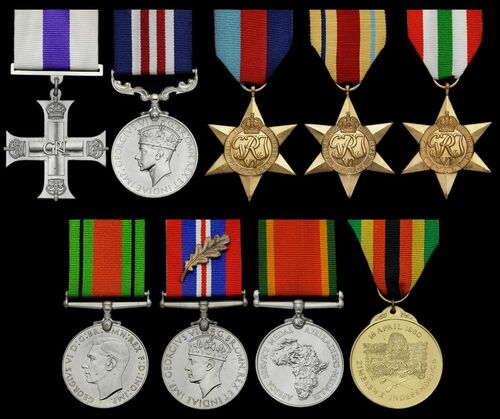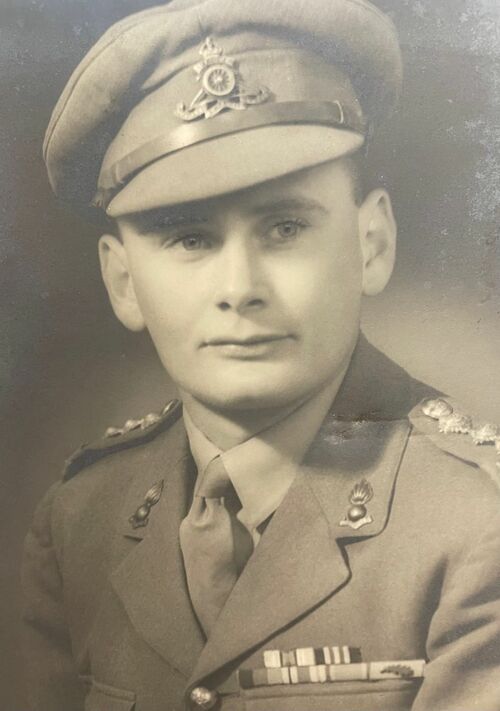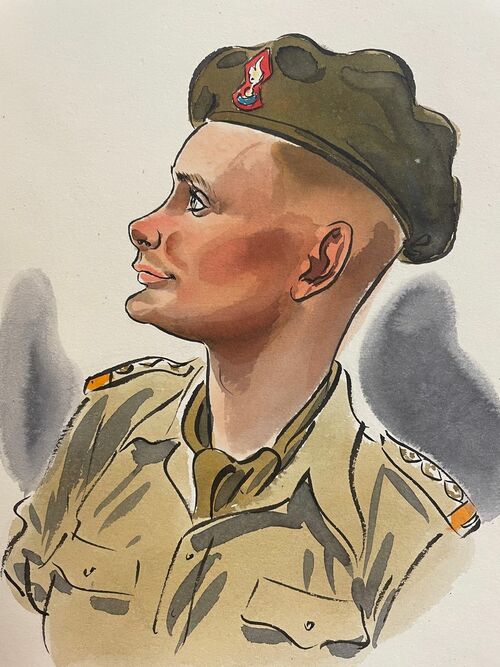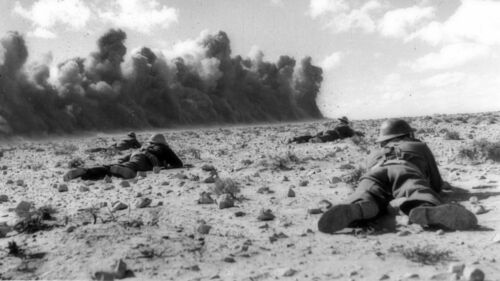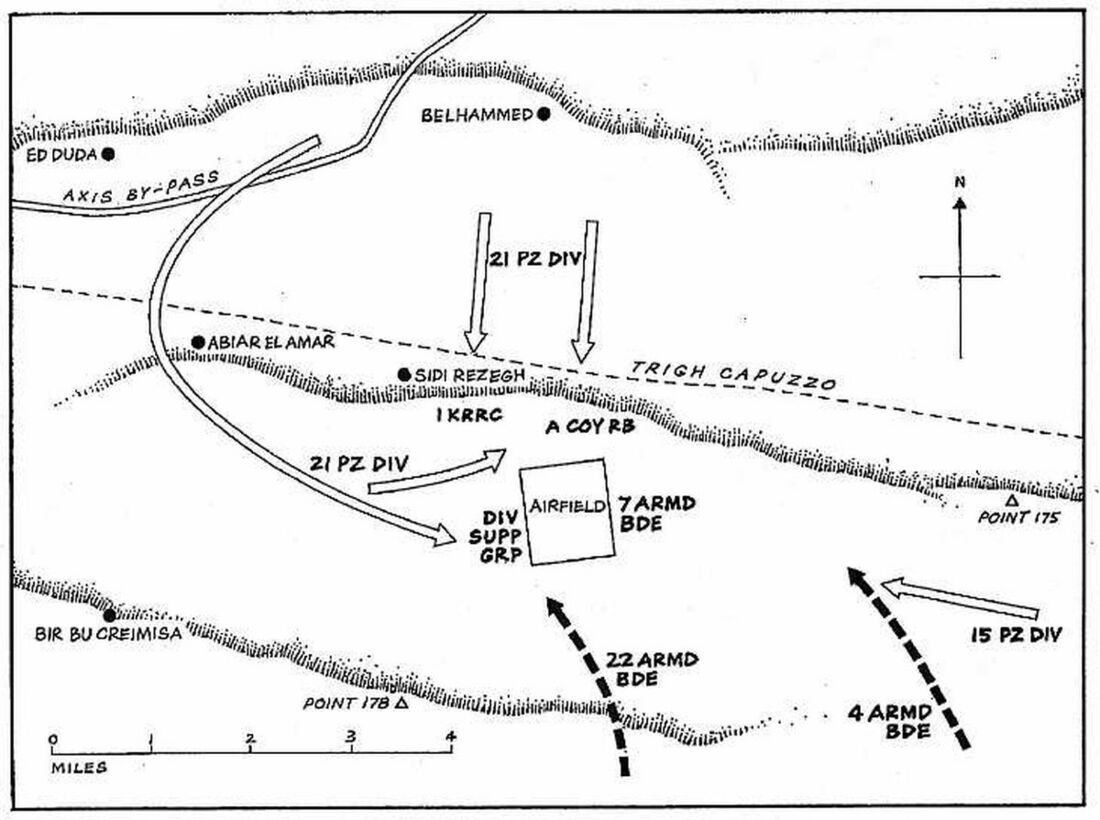Auction: 23001 - Orders, Decorations and Medals
Lot: 385
Sold by Order of a Direct Descendant
An outstanding and well-documented 1945 Immediate Italy Operations M.C., Battle of Sidi Rezegh November 1941 M.M. group of nine awarded to Major P. T. Ellis, 1/6th Field Regiment, South African Forces, late Lance-Bombardier, Royal Artillery
Military Cross, G.VI.R., the reverse officially dated '1945'; Military Medal, G.VI.R. (1095623 L/Bmbr. P. T. Ellis. R.A.); 1939-45 Star; Africa Star; Italy Star; Defence and War Medals, with M.I.D. oak leaf; Africa Service Medal 1939-45 (Sr. 598436 P. T. Ellis); Zimbabwe, Independence 1980, officially numbered '5284', cleaned, good very fine (9)
M.C. London Gazette 8 March 1945. The original recommendation states:
'Captain Ellis was a Forward Observation Officer with 'A' Company, Witwatersrand/De La Rey Regiment, in the successful attack on Monte Stanco on the morning of 13 October 1944. He accompanied the forward infantry units in the first attack and although under heavy shelling and mortar fire while reeling out assault cable, he managed to use his automatic weapon frequently on retreating Germans. As soon as Company HQ was established as Castagieti, Captain Ellis and his OP Assistant, Bombardier G. A. Rademan, pressed on alone, without infantry cover and with total disregard for personal safety, to a point of vantage 500 yards ahead, and there established an OP. This OP was exposed and afforded little protection from the continuous small arms fire of the enemy. Shortly afterwards Captain Ellis observed ten enemy infantry endeavouring to withdraw from a ridge on his right rear, and he and Bdr. Rademan immediately engaged them with automatic fire and pinned them down sufficiently long for the advancing infantry to take them Prisoner. Captain Ellis remained at this OP despite the unabated hostile fire until visibility became good enough for observed shooting of his Unit's guns. In the half light he observed the enemy forming up for a counter attack in a wadi and immediately brought heavy fire to bear upon them, and after they broke he pursued them with artillery concentration as they retreated in disorder to the North-West. Later at 0600hrs he observed a strong force of the enemy forming up to counter attack in the area MR711226. He immediately brought down the full weight of the Divisional Artillery upon it and by this action undoubtedly smashed what promised to be a powerful counter attack, before it had properly begun.
During the rest of the day, although his OP was subjected to continuous fire, he engaged many important targets, and it was largely due to his efforts that any attempt by the enemy to counter attack was frustrated. Subsequent examination of the ground has established that he was responsible for the destruction of at least two Spandau posts and three mortars.
Captain Ellis by his enterprise, superlative shooting, and contemptuous disregard of danger over a long period, rendered most valuable support to the infantry and contributed materially to their success in taking and holding Monte Stanco.'
M.M. London Gazette 12 February 1942. The original recommendation states:
'On the 22 November 1941 L/Bdr. Ellis was the OPA at a FOP at the escarpment north of the aerodrome at Sidi Rezegh. When the main enemy attack came in their OP was struck, cut off and was subjected to heavy shelling and machine gun fire. Ellis assisted in passing fire orders. Later he helped to bring the OP Party back south across the aerodrome and through the enemy lines. This N.C.O.'s coolness and complete disregard for his own welfare was most outstanding and was a lesson to all ranks.'
Peter Temple Ellis was born at Bloemfontein on 31 May 1921 and enlisted at Salisbury, Rhodesia on 28 September 1939. Ellis first saw active service in the Western Desert with the 5th South African Brigade. In this first action, Ellis was thrown into the crucible of action. In the early afternoon of 21 November, Rommel attacked Sidi Rezegh with the 21st Panzer Division and captured the airfield. Fighting was desperate and gallant. For his actions during both days of fighting, Brigadier Jock Campbell, who commanded 7th Support Group, was awarded the Victoria Cross, whilst Ellis was duly rewarded with his richly-deserved M.M.. However, 21st Panzer, despite being considerably weaker in armour, proved superior in its combined arms tactics and pushed 7th Armoured Division back with a further 50 tanks lost (mainly from 22nd Brigade).
The fighting at Sidi Rezegh continued until 22 November, with the South African Division's 5th Brigade had become engaged to the south of the airfield. An attempt to recapture it failed, and the Axis counteroffensive began to gain momentum. 7th Armoured Brigade withdrew; all but four of their 150 tanks had become out of commission or destroyed. In four days, the Eighth Army had lost 530 tanks; Axis losses had been about 100.
The most memorable action during the North African Campaign of the 3rd Field Regiment (Transvaal Horse Artillery) was during the Battle of Sidi Rezegh, on 23 November 1941. The South Africans were surrounded on all sides by German armour and artillery and were subjected to a continuous barrage. They tried to take cover in shallow slit trenches but in many places the South African soldiers could dig only to around 9" deep because of the solid limestone under their positions. The Transvaal Horse Artillery engaged German tanks from both the 15th and 21st Panzer Divisions, the gunners firing over open sights as they were overrun. That continued until many of the officers had been killed and the gunners had run out of ammunition.
Many of the gun crews were captured; as night fell those who could do so escaped back to Allied lines under the cover of darkness, much like in his fine citation.The gunners of the 3rd Field Regiment managed to save five of their 24 guns from the battlefield and later recovered seven other guns. After the Battle of Sidi Rezegh, Acting Lieutenant General Sir Charles Willoughby Moke Norrie stated:
'...the South African sacrifice resulted in the turning point of the battle, giving the Allies the upper hand in North Africa at that time.'
Ellis was duly commissioned and found himself thrown into the Italian Campaign throughout 1944. His diary for the period gives some personal apprehension on 12 October:
'The WR/DLR attack tomorrow. I am with Bill Bareads again - I'm glad. I've been saving a bottle of gin for 14 days that I intend opening when I reach Kear. Kear is going to Dog Bay and John Halls. Have a feeling it's going to be a nasty party.'
It would not be 'till 17 October he was able to write again and shed some light on the action which won his M.C.:
'We've been pulled out - the CTH have pushed on across the valley. Two boys of WR/DLR have relieved the RNC who are attacking this afternoon.
Since Stanco I've had time for a few impressions to settle. Bill did very well going on as he did after our Platoon had. Then there was getting to the top area having the Bosche talking 200-300ft below us in the bush; seeing hoards of them streaming away down the wadi west and having M Tgts fall on them; having mortars paste us, going to a place from where a Cpl had seen the mortars & calling for scale 10 on them (They collected 3 mortars there & 2 Spandaus). Slipping & falling down the mountain and getting wet. Bill & I sharing a bed at night, being weary and not being able to sleep because of the worry of a counter-attack. Also there was some good shooting we had when the pocket behind us dissolved & stray Bosche rushed across our front. THAT pocket shot stretcher bearer parties incidenitally - the bastards!
Rademan did good work there - a hard job thoroughly, in spite of all sorts of distraction. Have suggested he be put up for a gong.
...Everyone including myself is a bit jumpy. A lot of the Infantry chaps are feeling the strain. P.W.'s taken here are flown to Russia & Western Front say that they have never seen or endured Arty fire so intense and accurate.'
Rademan did indeed get the M.M. which Ellis put him up for. Returned to his native Rhodesia after adding a 'mention' (London Gazette 19 July 1945, refers) to his laurels to go with his two decorations, Ellis was confirmed as Captain in March 1961.
Sold together with an outstanding and comprehensive original archive comprising:
(i)
His M.I.D. certificate, together with Soldier's Service & Pay Book (Army Book 64) and Captain's Appointment.
(ii)
His diaries, providing excellent details into his service, covering the closing years of the Second World War, a fantastic first-hand account of this campaign.
(iii)
A remarkable and unpublished quantity of photographs of the Italian campaign, these offering a unique snapshot to the contribution of the South African Forces in this theatre, a good number annotated to the reverse.
(iv)
A series of photographs of the recipient.
(v)
A number of typed manuscripts, these including his unpublished novels and poems based on his experiences.
(vi)
A caricature of Ellis, painted in Rome in 1944, with the additional inscription 'It's a horrible thought that I do look like this. Peter.'
For his miniature dress medals, please see Lot 479. For the Medal of his grandfather, please see Lot 44.
Subject to 20% VAT on Buyer’s Premium. For more information please view Terms and Conditions for Buyers.
Sold for
£5,200
Starting price
£2000

